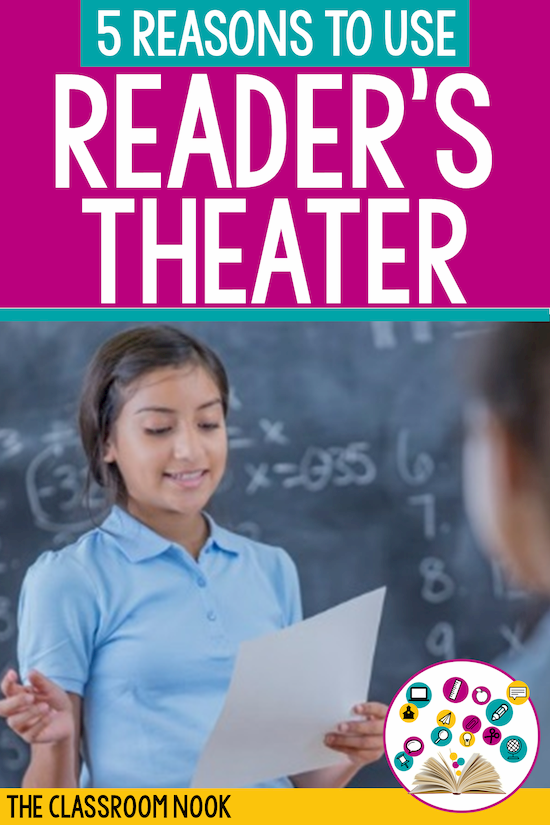Five Reasons Why You Should Use Reader’s Theater in the Upper Elementary Classroom

I’m a big proponent of using Reader’s Theater in the classroom. It’s a simple, engaging alternative to dry, traditional textbook study. Reader’s Theater also helps develop reading fluency and comprehension, while promoting cooperative learning. All this, and it's fun for both teacher and student! What’s not to like?
You May Also Like to Read: ALTERNATIVES TO BORING OR OUTDATED TEXTBOOKS
What is Reader’s Theater?
Simply put, Reader’s Theater is students reading a script adapted from literature or other subject matter, to a small group of fellow students. The reader attempts to put the material across in a way that allows the audience to visualize the action. To do this, the reader concentrates on using vocal cues and reading in an expressive manner.
Why Use Reader’s Theater?
It’s Useful and Purposeful
Reader’s Theater involves students in:
Reading/Speaking – Each student prepares ahead of time, and then takes a turn acting out their portion of the prepared script. To be able to “act out” the content, projecting and interpreting its meaning, students must work more closely with the text. Repeated exposure to the text results in improved vocabulary, comprehension, fluency, and retention.
Writing – Teachers can demonstrate script development and then create several scripts with a class before asking the students to create their own scripts in small groups. Students can be shown how to prepare their own script from a selected passage.
Listening – Students in the audience attempt to absorb the meaning of the passage using clues from the reader’s delivery.
That’s a lot of direct benefits to your students (not to mention Common Core coverage) stemming from a single exercise!
It’s engaging
Reader’s Theater allows students a more active role in their own education, and allows them to “act out” in a controlled, productive manner. Readers are encouraged to be extroverted, funny, even outlandish, so long as it serves the purpose of making a reading entertaining and memorable to listeners. This provides a nice break from typically dry reading exercises, and grabs the attention of students of all types. Enthusiastic readers enjoy being showcased, and even reluctant readers are drawn out by all the fun, and begin to gain confidence.
It’s Adaptable
There is really no topic that you can’t incorporate into a Reader’s Theater piece. When creating these pieces, I usually just take the information that I want students to learn from the textbook, and then create characters to present that information in their dialogue. A little added humor where appropriate, and voila!
It’s collaborative
Students participating in a Reader’s Theater exercise can work together to develop a script, practice their reading together, and act as one another’s audience. Students also become each other’s reading role models, which has been shown to improve reading skills.
It’s simple
Reader’s Theater is not a full-blown play. It doesn’t require sets, costumes, props, or memorized lines. All that’s necessary are several copies of the script, and students seated in a circle. That’s it!
Ready to Try Reader’s Theater?
So, do you want to give it a shot? Not sure where to start? Here are some tips for getting started with Reader’s Theater!
Select text for your script
As I mentioned earlier, Readers Theater can be performed with almost any type of content: short stories, portions of novels, history and science topics, and on and on. Not every piece of content, however, makes a good Readers Theater script. Look for content that:
is interesting and compelling
has interesting characters, conflict, action, and humor
is not overly full of descriptive passages
deals with high interest topics and popular characters
uses challenging vocabulary
addresses your current areas of study
Do your prep work
There is, of course, a bit of work involved in getting Reader’s Theater off the ground. The good news is that you can re-use scripts yearly, once you’ve created them.
Create your script(s)
Make multiple copies of each new script
Highlight the students’ parts ahead of time
Keep the pre-highlighted scripts in plastic sleeves in a three-pronged folder
Next steps
Once you have a couple of scripts on hand, it’s time to get started! Here’s how to ease in:
Demonstrate expressive reading for your students, often. Show them how it’s done!
Allow students to try Reader’s Theater several times with your shortest prepared scripts before asking them to create their own. This will give them the chance to grasp the concepts involved.
Allow plenty of time for preparation. Practice, practice, practice. Readers should practice both on their own and in front of others. Send a copy of the script home so that students can practice with their parents.
Rehearse with your students, and provide direction regarding interpretation, pacing, expression, and volume.
Don’t worry! It may not go perfectly at first, but just go for it and make any changes as necessary.
